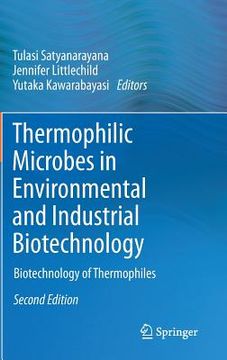thermophilic microbes in environmental and industrial biotechnology: biotechnology of thermophiles (in English)
Synopsis "thermophilic microbes in environmental and industrial biotechnology: biotechnology of thermophiles (in English)"
The existence of life at high temperatures is quiet fascinating. At elevated temperatures, only microorganisms are capable of growth and survival. A variety of microbes survive and grow at such high temperatures. Many thermophilic microbial genera have been isolated from man-made (washing machines, factory effluents, waste streams and acid mine effluents) and natural (volcanic areas, geothermal areas, terrestrial hot springs, submarine hydrothermal vents, geothermally heated oil reserves and oil wells, sun-heated litter and soils/sediments) thermal habitats throughout the world. Both culture-dependent and culture-independent approaches have been employed for understanding the diversity of microbes in hot environments. These organisms not only tolerate such high temperatures but also usually require these for their growth and survival. They are known as thermophiles/thermophilic microbes, which include a wide variety of prokaryotes (Bacteria and Archaea) as well as eukaryotes (Fungi, Algae, Protozoa). Interest in their diversity, ecology, and physiology has increased enormously during the past few decades as indicated by the deliberations in international conferences on extremophiles and thermophiles every alternate year. The Phylogenetic relationship of the known microorganisms indicates the presence of thermophilic microorganisms at the position close to the Last Universal Common Ancestor (LUCA). It is widely accepted that metal-reducing microorganisms have a large impact on the geochemistry of subsurface environments through the cycling of metals and organic matter, and thereby affect water quality and taste. Furthermore, metal-reducing micro-organisms have potential applications in bioremediation, mineral leaching and energy generation processes and are of evolutionary interest as metal reduction is considered to be a very ancient form of respiration. Protein characterization surprisingly indicated that possible additional functionality and alternate site promiscuity could contribute to the diverse biochemical abilities of the bacteria, especially with respect to microbe-metal interactions. Thermophilic bacteria are also able to reduce a wide spectrum of other metals including Mn (IV), Cr (VI), U (VI), Tc (VII), Co (III), Mo (VI), Au (I, III), and Hg (II) which can be used for immobilization of toxic metals/radionuclides, e.g. for the bioremediation of hot waste water of disposal sites of radioactive wastes having temperature range favorable for thermophiles for a long period of time. The main sources of CO in hot environments inhabited by anaerobic thermophiles are volcanic exhalations and thermal degradation of organic matter. A number of phylogenetically diverse anaerobic prokaryotes, both Bacteria and Archaea, are known to metabolize CO. CO transformation may be coupled to methanogenesis, acetogenesis, hydrogenogenesis, sulfate or ferric iron reduction. The key enzyme of anaerobic CO utilization, the Ni-containing CO dehydrogenase, is synthesized in hydrogenogens as an enzyme complex with the energy-converting hydrogenase. The genomic analysis shows this enzymatic complex to be encoded by a single gene cluster. Themophilic moulds and bacteria have been extensively studied in plant biomass bioconversion processes, as sources of industrial enzymes and as gene donors for the heterologous expression of thermostable enzymes. In the development of third generation biofuels such as bioethanol, thermophilic fungal and bacterial enzymes are of particular interest. The entire genomes of several thermophilic bacteria and archaea have already been sequenced. The analysis of the genomic data provided resources for novel and useful proteins and enzymes. The entire genomic data have also provided specific feature of microbes and important information on the evolution of thermophilic microorganisms. In some thermophilic archaea, multiple types of chaperonins have been identified. The chaperonins have been found to change according to the environmental conditions, suggesting that the mechanism for maintaining correct structure of thermostable proteins in the thermophilic archaea is regulated by changing chaperonine molecules. These organisms have evolved several structural and chemical adaptations, which allow them to survive and grow at elevated temperatures. Thermostable enzymes play an important role in the biosynthesis of fine chemicals. They are generally more robust against the conditions of industrial biocatalysis utilized by the industry, which can be solvent based or at elevated temperatures. Many non-natural industrially interesting substrates are often not soluble under aqueous conditions and at ambient temperatures. The thermophilic Archaea are a good source of these enzymes, which have been cloned and over-expressed in Escherichia coli. These include alcohol dehydrogenases for chiral alcohol production, aminoacylases for optically pure amino acids and amino acid analogues, transaminases for chiral amine production and gamma lactamases for chiral gamma lactam building blocks which are subsequently incorporated into carbocyclic nucleotides. Considerable interest has been generated in the mechanism that nature utilizes to increase the stability of enzymes found in thermophilic and hyperthermophilic species. A comparative approach has been used to carry out a detailed study of specific enzymes from a range of organisms in order to understand acquired stability at a structural level. A directed or site-specific mutagenesis approach has been used for stabilizing mesophilic proteins. The specific mutations have been introduced by looking at the most primitive forms of life, which are thought to have evolved in a thermophilic environment. The book is aimed at bringing together scattered up-to-date information on various aspects of thermophiles such as the diversity of thermophiles and viruses of thermophiles, their potential roles in pollution control and bioremediation, composting and microb

